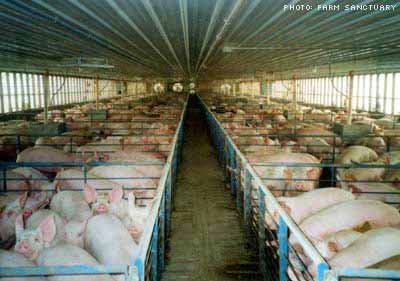 The first case of H1N1 swine flu virus was discovered in a North Carolina factory farm in 1998, not in Mexico. Within months of the 1998 emergence, the virus showed up in Texas, Minnesota, and Iowa.
The first case of H1N1 swine flu virus was discovered in a North Carolina factory farm in 1998, not in Mexico. Within months of the 1998 emergence, the virus showed up in Texas, Minnesota, and Iowa.
Dr. Robert Webster, one of the world’s leading experts of flu virus evolution, blames the emergence of the 1998 virus on the “recently evolving intensive farming practice in the USA, of raising pigs and poultry in adjacent sheds with the same staff,” a practice he calls “unsound.”
 Influenza in pigs is closely correlated with pig density,” said a European Commission-funded researcher studying the situation in Europe.
Influenza in pigs is closely correlated with pig density,” said a European Commission-funded researcher studying the situation in Europe.
Given massive concentrations of farm animals within which to mutate, these new swine flu viruses in North America seem to be on an evolutionary fast track, jumping between species at an unprecedented rate. Changes in animal husbandry, including increased vaccination, may be spurring this evolutionary surge after years of stability, according to science writer Bernice Wuethrich in Washington DC.
Is Smithfield Foods, the world’s largest pork packer and hog producer, linked to the outbreak?
Hundreds of industrial-scale hog facilities that have sprung up around Mexico in recent years, and the thousands of people employed inside the crowded, pathogen-filled confinement buildings and processing plants.
Cheaper labour costs and a desire to enter the Latin American market are drawing more industrialized agriculture to Mexico all the time, wiping out smaller, traditional farms, which now account for only a small portion of swine production in Mexico.
Smithfield operates massive hog-raising operations Perote, Mexico, in the state of Vera Cruz, where the outbreak originated. The operations, grouped under a Smithfield subsidiary called Granjas Carroll, raise 950,000 hogs per year, according to the company Web site www.granjascarroll.com.
The Mexico City daily La Jornada has also made the link. According to the newspaper, the Mexican health agency IMSS has acknowledged that the orginal carrier for the flu could be the “clouds of flies” that multiply in the Smithfield subsidiary’s manure lagoons. Residents [of Perote] believed the outbreak had been caused by contamination from pig breeding farms located in the area. They believed that the farms, operated by Granjas Carroll, polluted the atmosphere and local water bodies, which in turn led to the disease outbreak
According to residents, the company denied responsibility for the outbreak and attributed the cases to “flu.” However, a municipal health official stated that preliminary investigations indicated that the disease vector was a type of fly that reproduces in pig waste and that the outbreak was linked to the pig farms. It was unclear whether health officials had identified a suspected pathogen responsible for this outbreak".
Call it "intensive animal farming", "factory farming“, or "industrial farm animal production.” The report from the Union of Concerned Scientists prefers the term “confined animal feeding operations.”
No matter what you call it, it adds up to the same thing. Millions of animals are crowded together in inhumane conditions, causing "significant environmental threats and unacceptable health risks for workers, their neighbours and all the rest of us".
All farming should be organic and free-range. Any intensive livestock production can be challenged morally, biologically and on humane grounds. What is bad for animals ultimately is also bad for humans!
See also: The Worst Way of Farming in the New York Times of 31 May 08, Swine-flu outbreak linked to Smithfield Factory Farms in the Health Freedom Alliance blog of 25 Apr 09.

Add comment